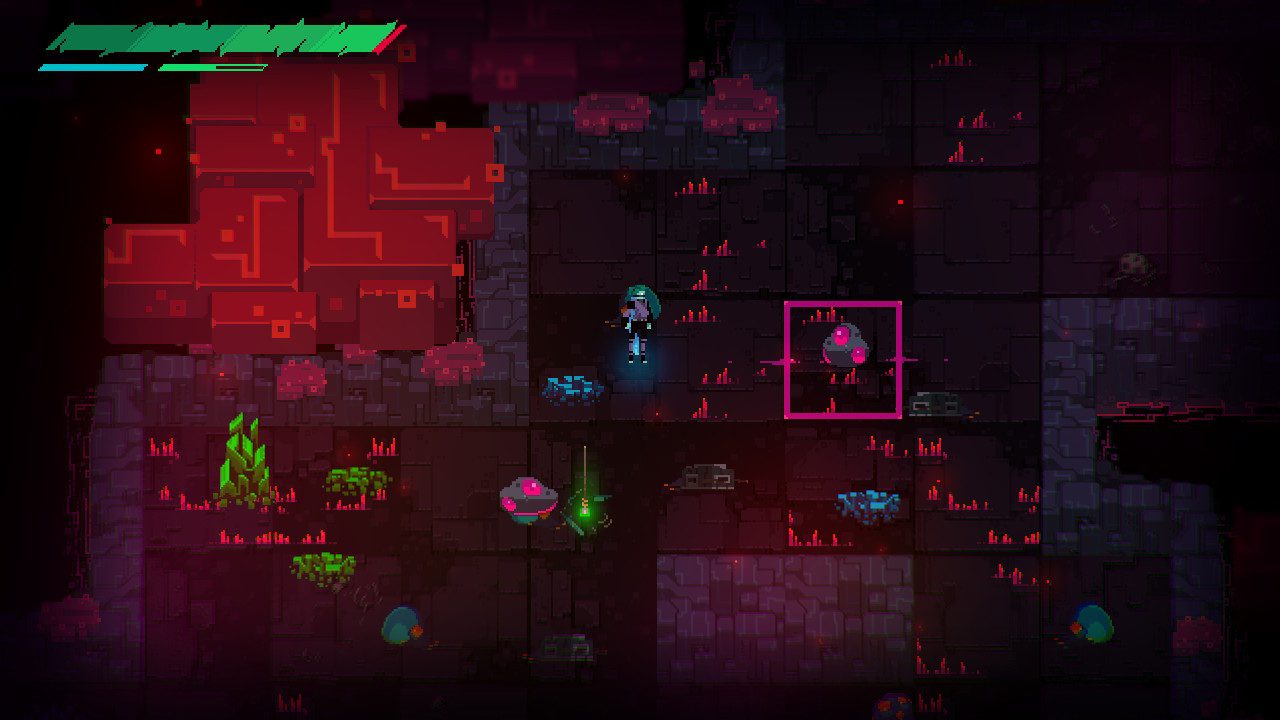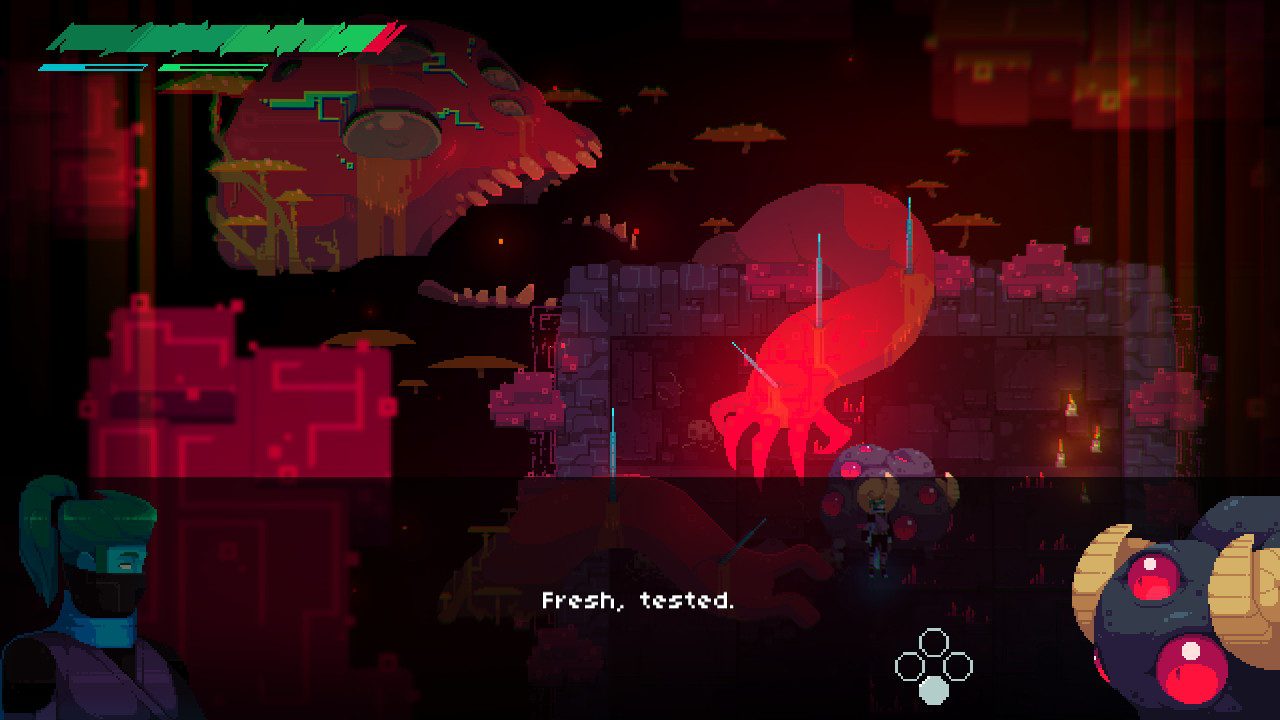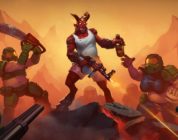A while back I played a preview of Phantom Trigger, which was developed by Bread Team and published by Tiny Build. During that preview, I came away pretty intrigued at the general premise of the story, but I wasn’t enthralled with the combat. Now the game has launched on PC and Switch and has been available for the past couple weeks. Usually, I would have had this review done a while back, for the game only took about four hours to beat, but I was honestly waiting for a patch to come through. Phantom Trigger is incredibly flawed, both in performance and design. Let’s dissect where things went wrong and where there are merits to praise.
Phantom Trigger is a retro-themed, top-down, hack-and-slash adventure game starring Stan. Stan is an ordinary fellow, until he is stricken with a terminal illness. To survive, Stan is reluctantly put through an experimental procedure that warps his perception of reality, putting him in a strange parallel universe. This weird world is inhabited by grotesque, barely humanoid monsters and animal-like companions. These animals give the player a bit of guidance as they go through each level, often becoming one of the few points of tension in the game. This is all wrapped up in a neon colored, psychedelic visual style that mimics old school games and calls back to films like Blade Runner or Sucker Punch.
As a narrative, Phantom Trigger has some intriguing moments. Players will often find themselves entering an area, only to have the screen flicker into Stan’s reality, where he talks with his wife and the doctors. These conversations are well-written and tense, dripping with meaning beyond their set words. The animal companions also get similar setups and depending on what items are given to them it could alter the game’s narrative path and ending. For example, one darker NPC tells Stan to kill everyone in the hub world. Doing this is fairly easy. Poison the rabbit with a spice she can’t eat, chop down the tree with a sword, but doing these dark deeds feels incredibly wrong. I was on that path by pure accident and quickly reloaded a save, just to keep some of them alive.
Unfortunately, that’s where the fun ends for Phantom Trigger, which is plagued by poor design choices. Combat falls into three weapons and a dash, all mapped to the face buttons. Dashing, one of the main forms of movement, can be done about three times before running out of steam for a couple seconds. While dashing is a quick way to get out of harm’s way or cross a dangerous line of fire, the level design doesn’t compliment this movement skill. Often the dash comes up short or goes too far, dropping Stan on spiked plants or in direct damage from an enemy. This is made worse by areas that require the player to kill all the monsters in a space, similar to a beat-em up game or Devil May Cry. These gated areas are by far the most frustrating, as they are rarely big enough to use all of the abilities properly, locking Stan in with enemies that just feel lacking.
Enemy design doesn’t allow for player expression. Most enemies have a couple frames of attack and their movement speed is about twice as fast as walking Stan. This leads to a cat and mouse style of combat that just leads to aggravation more than anything else. One enemy in particular, a bouncing purple blob, is by far one of the worst things I’ve seen in gaming in years. These little bastards can’t have much more than a single frame of vulnerability. Plus ,when they land they throw out a barrier of pain that does way more damage than it should. Anytime these show up (which they do in almost every encounter after they’re introduced) it becomes an awkward shuffle to hit them. One wrong move and its death for Stan, as attacks quickly stack up.
This poor enemy design, coupled with cramped spaces, and weird player movement, makes for a rough time.
Stan’s weapons include a sword shorter than Link’s in Link to the Past, a whip that’ll bring enemies closer or throw objects highlighted in green, and two big fists. The whip is a quick way to take damage, as most enemies attack close to their bodies, so usually pulling them in just results in being hurt. The sword is far too short, which causes a similar problem. The fists is how I beat the game, due to their larger hitbox and damage output. Now, before I go into my strategy, I have to talk about the game’s overall combat system.
Similar to God of War or Ratchet and Clank, Phantom Trigger‘s weapons get stronger by using them. Leveling them up gives access to different combination attacks, like freezing enemies, dashing a line of fire, or creating spirit blades that follow Stan like boomerangs. Most of these moves are useless, leaving me to mostly use the freeze attack from early game and the spirit blades. The rest of the attacks just don’t hit hard enough, or stun the enemies to go into longer combos.
I beat Phantom Trigger in the most boring, but most effective, way possible. I walked around, dashing rarely in combat, and used the first attack animation of the fists, freezing enemies if they got out of hand. This led to the dullest combat I’ve played in a game like this and it was an absolute test of my will to get to the end of the game. Most combat encounters were just attempts to get out and make it to the next checkpoint, which only heal the player the first time they’re reached, and hoping I was making progress. Each level is built like a maze, with some side avenues to get items for story purposes or more experience for one’s weapons, that end in a boss fight.
Boss fights in Phantom Trigger are laughably awful. The first one is pretty interesting as Stan battles a beetle with shield-like arms, but then they get annoying. The second bosses are two teleporting towers that continuously spawn basic enemies. The only way to damage these towers is to kill hundreds of the little basic dudes and it takes what seems like forever without any player feedback to ensure them that what they are doing is the correct way to win. One of the last bosses is another gauntlet of enemies, but with a high damage laser that sweeps the room. This terrible boss is used twice. . . These enemies are also devoid of any character, mostly being symbolic monoliths that make getting through a level that much worse. I’m pretty sure they’re based on Chess pieces too, but that doesn’t really add to anything.
All of these issues culminate in the final level, which takes place in the hub world. Stan returns to find the portal he’s been using swarming with demon arms and brambles choke the area. After finding a side path, he finds himself in a maze that loops back around to another room in the hub area. I spent like two hours in this spot alone, and mind that it only takes like twenty minutes to go through the maze, likely due to my player not triggering some invisible line to actually let me proceed. It had the potential to be a really cool final level, but the bugs in it made almost unplayable, leaving me to wander in circles and quickly going mad.
Those who do decide to power through though, will find multiple endings that drastically change the game’s outcome. I would like to go through a few more times, just to see how the narrative changes, but I just can’t stomach playing it anymore.
Which brings me to the game’s performance issues and bugs. There are several, a few of which can halt progress entirely. Before even starting the game, there is a splash screen to load the game. It takes almost a full minute to load in, with no indication of how much longer is left. I assumed the game was borked and restarted a couple times. Frame rate dips constantly, which is made more apparent with those purple bastards. Progress switches don’t work all of the time. The tower boss I mentioned earlier can be easily beat, but sometimes doesn’t let the player leave the area. Level design is lackluster and confusing. It’s appalling this was even released onto Switch at all.
Now, I do hear that Phantom Trigger has gotten a few patches on PC that make things a bit better. The Switch version is in DESPERATE need of this patch. However, there are problems with Phantom Trigger‘s design that a patch just wouldn’t fix. There are some cool ideas in Phantom Trigger and its art direction can be really cool, but there isn’t enough synergy between the game’s various systems to make it worthwhile.
There are a few things that could be tweaked to make this game worth another go, but it’ll take months of dedicated rebuilding and by that time, where will those few fans be.
Phantom Trigger, at least the Switch version, should’ve been delayed.
For more information on Phantom Trigger, check out the official website. A review code was provided for the purpose of this review.










